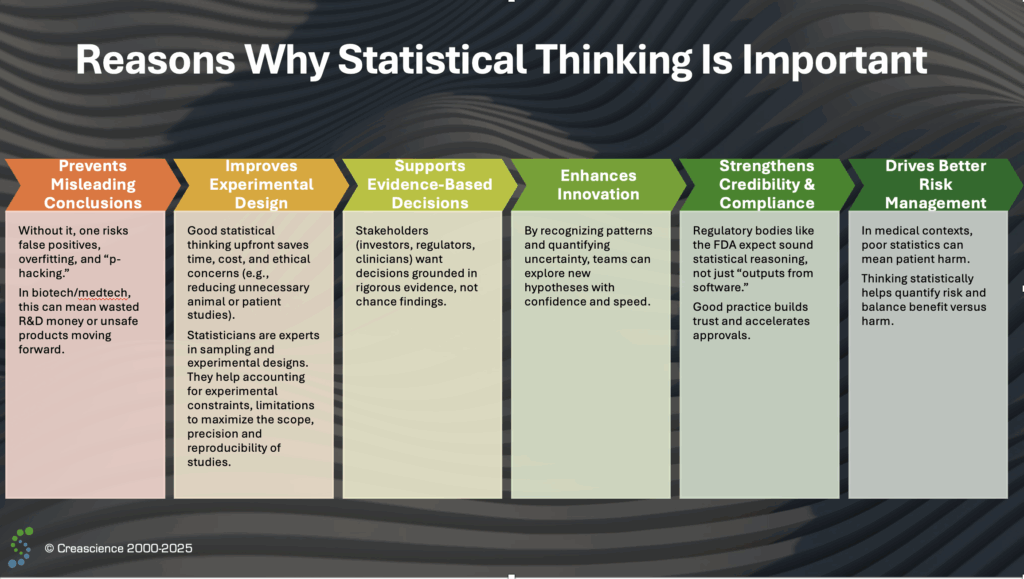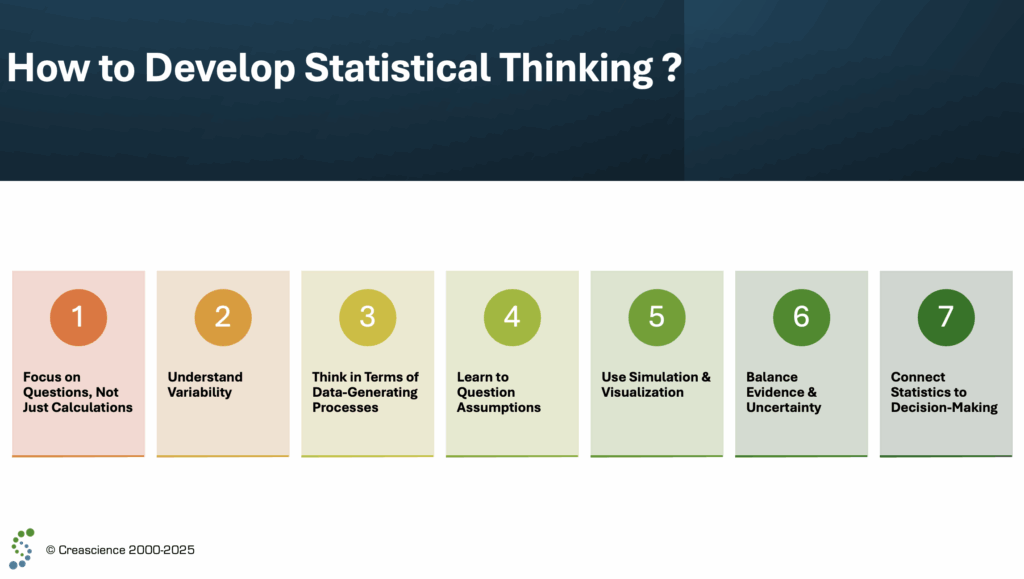What is Statistical Thinking?
Statistical thinking is an approach to problem-solving that involves understanding and applying concepts from statistics to make informed decisions and draw conclusions. It is not about crunching numbers, but about thinking critically and systematically to understand variability, patterns, and relationships in data.
🎯 Statistical thinking helps structure and consolidate research activities so that they are reproducible, robust, reliable and accurate. It should be implemented in various study stages.
- Planning phase of studies:
- Define a clear research question & corresponding endpoints
- Clear definition of the study population(s)
- Define a sampling strategy
- Define the relevant effect size to detect (along with its justification)
- Get an estimate of sample size
- Develop an experimental design
- Develop a statistical analysis plan (SAP): how to manage missing data, how to manage outliers, how to statistically analyse data, robust methods, sensitivity analyses, etc.
- Develop a data collection strategy, data storage, data coding, data dictionary, …
- etc.
- Data collection process
- Monitor data quality
- Use data dictionary & storage conventions
- Statistical analysis of data
- EDA
- Statistical testing/analysis/modelling
- Checking adequacy of method to data
- Interpretation & depiction of study results: statistical significance. vs. practical relevance.
- Communication of study results
- Define the scope of the study results, risk of bias, confounding, etc.
- Define the precision of the results.
- Describe what precautions we taken to maximise results robustness & reproducibility.
Statistical thinking applies rigorous principles to research design and analysis, proving essential in biotechnology and medical research by minimizing errors and optimizing complex data analysis.
Statistical thinking means applying rigorous principles in research design, data analysis, and uncertainty quantification. Bretz and Greenhouse (2023) describe it as essential for addressing big data and complex research questions in biopharmaceutical contexts, while Chan (2013) and O’Leary (2021) stress that it bolsters methodological rigor and reproducibility in medical investigations. Stang et al. (2010) and Strasak et al. (2007) note that relying solely on p-values can mislead interpretation; instead, incorporating measures such as effect sizes and confidence intervals yields more meaningful insights.
In biotechnology and medical research, statistical thinking is portrayed as vital for early integration into study design. Nadon and Kayne (2018) and others observe that proactive statistical planning minimizes errors, enhances research quality, and optimizes the analysis of high-throughput and complex datasets. Modern computational advances further underscore the need for researchers to develop skills that combine traditional statistical methods with innovative data-handling techniques.
Some Key Aspects of Statistical Thinking
Understanding Variation
Statistical thinking emphasizes the recognition that data vary, and understanding why and how things change is crucial.
This involves recognizing the difference between random variation and true signals in the data.
Collecting & Analyzing Data
Collecting data in a predetermined way and using appropriate methods to analyze them.
This involves selecting the right sampling techniques, designing experiments, and applying statistical methods like hypothesis testing, regression analysis, etc.
Making Inferences
From a given dataset, statistical thinking helps you make inferences about larger populations or predict future outcomes.
This could involve estimating averages, proportions, or understanding trends in the data.
Quantifying Uncertainty
Statistical thinking embraces the idea that all conclusions are subject to some level of uncertainty.
It uses concepts such as confidence intervals and p-values to express and account for this uncertainty.
Decision-Making
Statistical thinking aids in decision-making by providing a framework for making reasoned, data-driven choices while considering the risks, uncertainties, and potential consequences
Why is Statistical Thinking Important ❓
Statistical thinking is very important because it provides a structured way to understand variation, uncertainty, and evidence in data — all of which are central to sound decision-making.
🔹 Instead of relying on anecdotes, intuition, or chance patterns, statistical thinking encourages people to ask the right questions, design studies properly, analyse empirical results with appropriate statistical methodology and interpret results critically.
🔹 Statistical thinking emphasizes that data are not absolute truths but observations subject to error, bias, and noise, and that conclusions must be drawn with these limitations in mind.
🔹 Involving a statistician from the start saves time, money, and credibility. A well-designed study avoids wasted data collection, meets regulatory and publication standards, and produces results that truly support decisions.
🔹 Some researchers underestimate the complexity of study design and analysis, assuming statistics is just a matter of “running tests” rather than shaping the entire research strategy.
🔹 Without statistical input, even good science risks being underpowered, misinterpreted, or rejected.
Do you consult statisticians right from the start?

How to Develop Statistical Thinking?
Over the last 30 years I trained and coached tens of thousands of scientists, chemists, biologists, engineers, etc. They are all looking for ways to improve their statistical thinking. As opposed to common conceptions, statistical thinking relies on a lot of common sense and logic.
Based on my experience, here are key elements to consider to improve the “statistical mindset”.
1. Focus on Questions, Not Just Calculations
▫️ Start with what problem needs answering rather than “what test should I run.”
▫️ Frame hypotheses, define outcomes & risks that can be tolerated, and think about the meaning of data before diving into formulas.
▫️Define effects to detect and do not neglect the sample size & power calculations.
2. Understand Variability
▫️ See variation as natural and informative, not just “noise.”
▫️ Practice distinguishing between signal (real effect) and noise (random variation).
▫️Think about all sources of variation that may impact the outcome(s) and try to anticipate their effects. Important to select an adapted experiment design.
▫️ Clearly define the study population(s). Make sure that experimental units are properly identified : key to defining true replicates vs. pseudo replicates. Consult an experienced statistician if you are unsure. This is really important!
▫️ Are you trying to control the experiment too much? What about scaling issues?
▫️ Have you considered running pilot studies or screening expts to identify the most influential factors in your process?
3. Think in Terms of Data-Generating Processes
▫️ Imagine how data were collected, what biases may exist, and what the underlying system looks like.
▫️ Ask: If I repeated the study, would I get similar results?
4. Learn to Question Assumptions
▫️ Every method relies on some underlying assumptions such as normality, independence, randomness.
▫️Train yourself to ask whether these hold in practice.
▫️Learn about robust methods and sensitivity analyses.
5. Use Simulation & Visualization
▫️ Simulate experiments to see how results change under different conditions.
▫️ Visualize data to develop intuition about distributions, patterns, & anomalies.
6. Balance Evidence & Uncertainty
▫️ Develop comfort with uncertainty — no single number (p-value, confidence interval, effect size) tells the whole story.
▫️Practice expressing results in terms of probabilities, risks, & trade-offs.
7. Connect Statistics to Decision-Making
▫️ Always link analyses back to practical decisions: regulatory approval, clinical impact, business implications.
▫️ Ask: How would different outcomes change what we do next?
▫️ Clearly establish the scope & limitations of your findings.
In short: statistical thinking transforms data into reliable knowledge & decisions.
It’s not about doing math — it’s about reasoning under uncertainty, which is exactly what biotech & medtech innovation require.

Summary
In summary, statistical thinking is about being skeptical, questioning assumptions, recognizing patterns, and using data and statistical methods to guide decisions and predictions in the face of uncertainty.
Early involvement of a statistician turns good research into reliable, publishable, and decision-ready evidence.
References
Fengxia Yan, Mayberry Robert, Yonggang Li (2017). Statistical methods and common problems in medical or biomedical science research. International Journal of Physiology, Pathophysiology and Pharmacology
F. Bretz, J. Greenhouse (2023). The Role of Statistical Thinking in Biopharmaceutical Research. Statistics in Biopharmaceutical Research
Massimiliano Russo, B. Scarpa (2022). Learning in Medicine: The Importance of Statistical Thinking. Methods in molecular biology
A. Strasak, Q. Zaman, K. Pfeiffer, Georg Göbel, H. Ulmer (2007). Statistical errors in medical research–a review of common pitfalls. Swiss medical weekly
Robert Nadon, P. Kayne (2018). Statistics and Biology: Not Your Average Relationship. SLAS discovery : advancing life sciences R & D
A. Stang, C. Poole, O. Kuss (2010). The ongoing tyranny of statistical significance testing in biomedical research. European Journal of Epidemiology
S. Glantz (1980). Biostatistics: how to detect, correct and prevent errors in the medical literature. Circulation
Timothy J. O’Leary (2021). Rigor, Reproducibility, and the p Value. American Journal of Pathology
W. Chan (2013). Statistical Methods in Medical Research. Model Assisted Statistics and Applications
D. Neuberg (2018). Statistics Everywhere. HemaSphereDownload BIBDownload RIS
Yan F, Robert M, Li Y. Statistical methods and common problems in medical or biomedical science research. Int J Physiol Pathophysiol Pharmacol. 2017 Nov 1;9(5):157-163. PMID: 29209453; PMCID: PMC5698693
